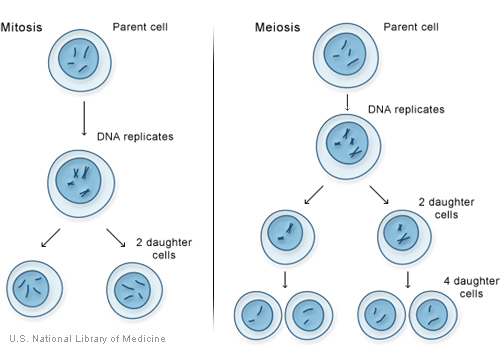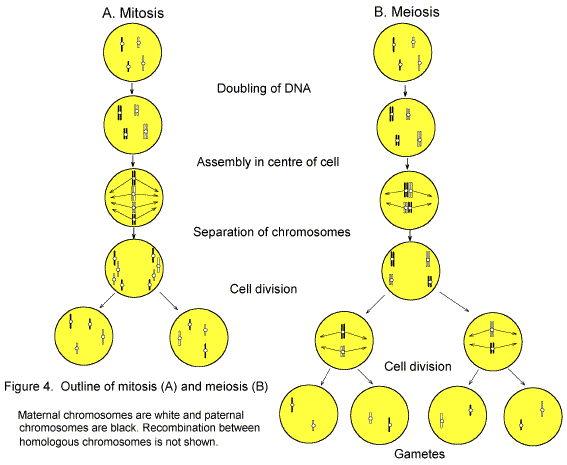Cell Cycle Review
Interphase- Stage at which the DNA(genetic
material) is doubled
Check Points - G1 and G2. The integrity of
the DNA is checked here.
Mitosis - Somatic Cell Division
2N-4N-2N
There is 1 cell division compared to 2 in Meiosis.
What is mitosis?
| Mitosis is nuclear division plus cytokinesis, and produces two
identical daughter cells during prophase, prometaphase, metaphase,
anaphase, and telophase. Interphase is often included in discussions of
mitosis, but interphase is technically not part of mitosis, but rather
encompasses stages G1, S, and G2 of the cell cycle. |
Interphase & mitosis
Interphase
 |
The cell is engaged in metabolic activity and performing its prepare for
mitosis (the next four phases that lead up to and include nuclear
division). Chromosomes are not clearly discerned in the nucleus,
although a dark spot called the nucleolus may be visible. The cell may
contain a pair of centrioles (or microtubule organizing centers in
plants) both of which are organizational sites for microtubules. |
Prophase
 |
Chromatin in the nucleus begins to condense and becomes visible in the
light microscope as chromosomes. The nucleolus disappears. Centrioles
begin moving to opposite ends of the cell and fibers extend from the
centromeres. Some fibers cross the cell to form the mitotic spindle.
|
Metaphase
 |
Spindle fibers align the chromosomes along the middle of the cell
nucleus. This line is referred to as the metaphase plate. This
organization helps to ensure that in the next phase, when the
chromosomes are separated, each new nucleus will receive one copy of
each chromosome. |
Anaphase
 |
The paired chromosomes separate at the kinetochores and move to opposite
sides of the cell. Motion results from a combination of kinetochore
movement along the spindle microtubules and through the physical
interaction of polar microtubules. |
Telophase
 |
Chromatids arrive at opposite poles of cell, and new membranes form
around the daughter nuclei. The chromosomes disperse and are no longer
visible under the light microscope. The spindle fibers disperse, and
cytokinesis or the partitioning of the cell may also begin during this
stage. |
Cytokinesis
 |
In animal cells, cytokinesis results when a fiber ring composed of a
protein called actin around the center of the cell contracts pinching
the cell into two daughter cells, each with one nucleus. In plant cells,
the rigid wall requires that a cell plate be synthesized between the two
daughter cells. |
|
Meiosis - Reduction Division
Packaging up half the genetic material into either sperm
or eggs
There are 2 divisions compared to 1 in Mitosis
2N-4N-2N-N



Only one oocyte gets all the nutrients, therefore the
others become polar bodies and die
Note: Homologous chromosomes pair up at Metaphase

Mendel's Laws
- Dominance vs Recessive
- Separation of Traits (
law of segregation: the 2 alleles from 1 gene go to different gametes)
- Law of Independent assortment
(random fashion in which the genes line up at Metaphase
Relating all this to Mendelian
Genetics
When you are looking at more than one trait.
Example
T = tall
t = small
R = round
r = wrinkled
When the chromosomes line up one combination can be
T R
XXXXXXX
OOOOOOO
xxxxxxxxxxx
oooooooooo
t r
Duplication at Interphase of Meiosis
then line up at Metaphase
T R
XXXXXXX
OOOOOOO
XXXXXXX
OOOOOOO
T
R SEPARATION OF THE TRAITS
t r
xxxxxxxxxxx
oooooooooo
xxxxxxxxxxx
oooooooooo
t r
Result in gametes is:
T and R
t and r
after 1 cell division
Note: There is no Tr and rR combination
There will be if the chromosomes line up
at Metaphase like this:
T r
XXXXXXX
oooooooooo
XXXXXXX
oooooooooo
xxxxxxxxxx
OOOOOOO
xxxxxxxxxx
OOOOOOO
t R
Result in gametes is:
T and r
t and R
Calculation phenotypic
and genotypic ratios for a dihybrid cross
So what we have is a dihybrid cross
(Two traits are involved)
Using height and shape as above
T = tall
t = short
R= round
r= wrinkled
TtRr x TtRr
Gametes that can be passed on are:
T and R
t and r
Because of Independent assortment other
possibilities are:
T and r
t and R
The possible gametes for both parents
will be the same since they are both heterozygotes for both traits
Using Punnet Square
TR Tr tR tr
TR
Tr
rR
tr
Branching Method
Or 3:1 x 3:1
3
1
3 9
3
1 3
1
Will produce a 9:3:3:1
phenotypic ratio
9 tall and round
3 tall and wrinkled
3 small and round
1 small and wrinkled
From this we can see the
genotypic ratio that is being formed.
Another way to
figure the genotypic ratio for a dihybrid cross is to think of it as a
monohybrid x monohybrid
If genotypic
ratio for a monohybrid cross is 1:2:1, a dihybrid cross would be 1:2:1 x
1:2:1
so:
1AA
1DD 1AADD
2Dd 2AADd
1dd 1AAdd
2Aa
1DD 2AaDD
2Dd 4AaDd
1dd 2Aadd
1aa
1DD 1aaDD
2Dd 2aaDd
1dd 1aadd
Giving
a genotypic ratio of?
Q. What is the probability
of one of the F1 being double recessive?









